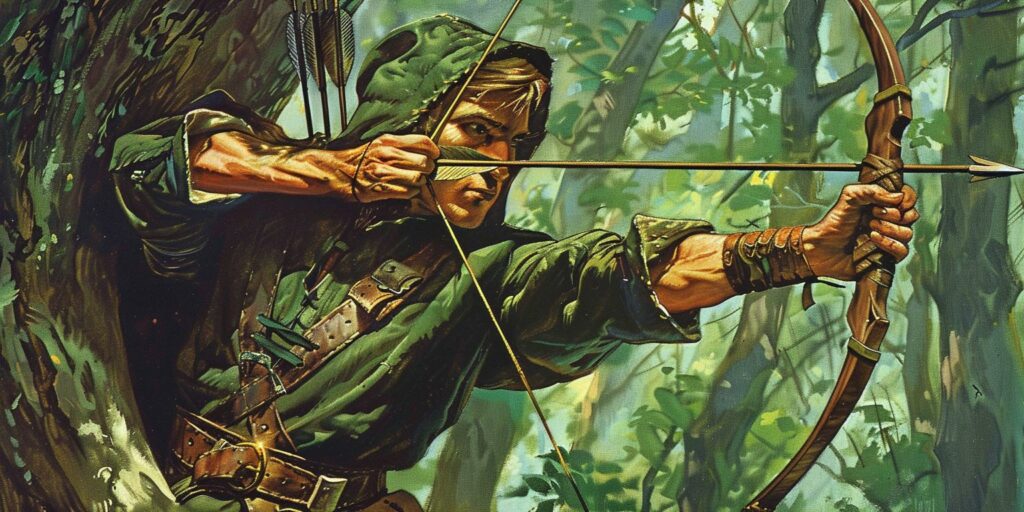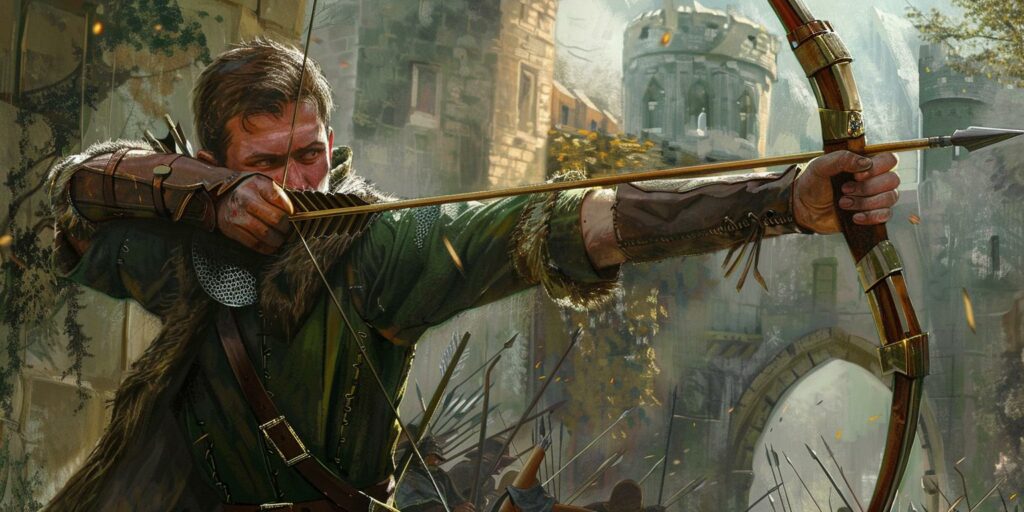The legend of Robin Hood, the skilled archer and outlaw who famously robbed the rich to give to the poor, has fascinated audiences for centuries. Set against the backdrop of the vast Sherwood Forest during medieval England, the story follows the daring adventures of Robin Hood and his band of merry men. These tales, retold in numerous forms, including literature, film, and television, blend historical ambiance with folklore, making it difficult to discern the line between fact and fiction.
The central question persists: Was Robin Hood a real historical figure, or is he merely a fictional character symbolizing resistance against tyranny? This exploration delves into the Robin Hood facts and narrative, seeking insights and dissecting the elements that have kept the legend alive through generations. As we peel back the layers of Robin Hood’s story, we examine whether he was inspired by an actual person from medieval England or if he is simply an enduring personification of heroism and rebellion.
Who Was Robin Hood and Was He a Real Person?
The Robin Hood Middle Ages legend, the skilled archer and outlaw who defied authority and robbed from the rich to give to the poor, has captivated imaginations for ages. The origins of this compelling tale can be traced back to the late 12th and early 13th centuries, with the first known literary references appearing in medieval ballads and rhymes, including “A Gest of Robyn Hode” and “Robin Hood and the Monk.” These early accounts depict a character called Robin Hood, or variations like Robyn Hood or Robyn Hod, who lived in Sherwood Forest and engaged in acts of defiance against the ruling authorities.
Origins of the Robin Hood Medieval Legend
The earliest versions of the Robin Hood legend emerged in the form of rhymes and ballads that circulated among the common people during the medieval era, significantly influenced by works such as “Piers Plowman” and “The Tale of Gamelyn.” These early works portrayed Robin as a skilled archer and outlaw who rebelled against the ruling class and fought for the rights of the downtrodden. The tales of Robin Hood and his band of “merry men” striking back against corrupt officials and redistributing wealth resonated with the struggles of the masses during a time of oppression and inequity.
Historical Evidence Supporting Robin Hood’s Existence
While no definitive historical proof of Robin Hood’s existence has been found, scholars have uncovered various pieces of evidence that suggest the legend may have been inspired by an actual person or group of outlaws. Early ballads and literary works mention figures like “Robyn Hood” or “Robyn Hod,” which could indicate a real individual associated with the stories. Additionally, records of outlaws are active in medieval England, some with similar names like “Robert Hood” or “Robin Wood,” who may have contributed to the legend’s development.
Debate Surrounding the Identity of the Real Robin Hood
Despite the historical evidence, scholars and historians continue to debate the true identity of the real Robin Hood, if he existed at all. Some argue that the tales were inspired by various outlaws and folk heroes of the time, with the legend evolving and embellishing over the centuries. Others suggest that Robin Hood was a symbolic figure representing the struggles of the common people against oppressive rulers and unjust taxation rather than a single individual.
This interpretation gains depth when considering the socio-political context of medieval England, where tensions between the ruling classes and the peasantry were often high. The Robin Hood stories, with their focus on social justice and redistribution of wealth, may well reflect the collective aspirations and grievances of the lower classes during periods of excessive feudal oppression and economic hardship. This perspective views Robin Hood not merely as a person but as a manifestation of the people’s resistance and a critique of the social order of the time.
The debate continues whether Robin Hood was based on a real person, an amalgamation of multiple outlaws, or a fictional character embodying the ideals of resistance and social justice. Regardless of his historicity, the enduring popularity of the Robin Hood legend demonstrates its universal appeal and the resonance of its core values, as epitomized in stories like “Robin Hood and the Golden Arrow” and “Robin Hood and the Bishop of Hereford.” These tales highlight themes of clever defiance against corrupt authority and the hero’s commitment to fairness and equality. The broad appeal of the Robin Hood legend, transcending time and cultures, underscores its potent blend of adventure, moral conflict, and the timeless struggle for justice.
What Were the Key Aspects of the Robin Hood Story?
The enduring legend of Robin Hood, a skilled archer and outlaw who defied authority, has captivated audiences for centuries. The ballads and plays about Robin Hood portray him as a hero who fought against injustice and oppression, engaging in daring exploits and outwitting corrupt officials.
Robin Hood’s Accomplishments and Deeds
According to the tales, Robin Hood and his “merry men” lived in Sherwood Forest, where they carried out acts of chivalry. They were known for robbing the rich to give to the poor, protecting the downtrodden, and defying the corrupt officials of the time. The Ballads depicts Robin as a skilled archer, swordsman, and leader who battled against tyranny.

Understanding Robin Hood’s Motives and Values
Throughout the various retellings, Robin Hood is portrayed as a champion of the common people, driven by a strong sense of justice and a desire to help the poor and oppressed. His motives were rooted in the belief that the wealthy and powerful had become corrupt and were exploiting the less fortunate. By redistributing the riches he acquired, Robin Hood upheld the values of equality, fairness, and standing up against tyranny – values that resonated with the masses during the medieval era and continue to resonate today.
Role of Sherwood Forest in the Tales of Robin Hood
Sherwood Forest, a vast expanse of woodland in Nottinghamshire, England, plays a central role in the Robin Hood legend. It served as the outlaw’s hideout and base of operations, providing sanctuary and protection from the authorities. The forest’s dense foliage and intricate network of paths allowed Robin and his band to move freely and evade capture. Sherwood Forest became an integral part of the legend, symbolizing the struggle between the outlaws and the ruling powers and the enduring spirit of freedom and resistance.
Did Robin Hood Really Steal from the Rich to Give to the Poor?
The notion of robbing the rich to give to the poor is a central theme in the Robin Hood legend and has become a popular cultural trope. While the stories depict Robin Hood and his men engaging in acts of theft and redistribution, it is essential to examine the historical context and understand the concept’s deeper significance. During the medieval era, there were significant disparities in wealth and power, with the ruling classes often exploiting the peasantry through excessive taxation and oppressive policies.
In this light, Robin Hood’s actions can be interpreted as a form of resistance against injustice and a quest for social equity, themes that are central to the story of “Robin Hood and the Potter.” In this story, Robin Hood disguises himself and competes in an archery contest, winning against the sheriff’s men. This tale showcases his prowess and cunning and highlights his ongoing efforts to challenge and subvert the authority of the corrupt elites. By engaging in these acts, Robin Hood not only redistributes wealth but also restores a sense of balance and fairness, symbolizing hope for the oppressed and serving as a beacon of justice and moral integrity.
Examining the Concept of Robbing the Rich and Giving to the Poor
The Gest of Robin Hood, an early ballad referring to Robin, portrays him as a skilled archer and outlaw who roamed the forests of Nottinghamshire, England, during the reign of Henry VIII. This ballad, along with other tales, depicts Robin Hood and his men robbing wealthy travelers, corrupt officials, and even the Sheriff of Nottingham and then distributing the riches among the less fortunate members of society.

Interpreting the Alleged Acts of Generosity by Robin Hood
The tales of Robin Hood frequently depict him as a generous figure who shared his spoils with the poor and needy. Accounts describe him and his men, including Little John, Friar Tuck, and Maid Marian, robbing wealthy monks and corrupt officials and then giving to the poor. These acts of generosity can be viewed as a form of social justice, addressing the economic disparities and providing relief to those who suffered under the oppressive rule of the time. However, it is important to interpret these stories within the context of the era and understand the symbolic significance they held for the common people.
Legacy of Robin Hood’s Ideals on Social Justice
Regardless of whether Robin Hood was based on a real person or a fictional character, the ideals he represented have had a lasting impact on the concept of social justice. The legend of an outlaw who defied authority and fought for the rights of the oppressed has inspired countless individuals and movements throughout history. Robin Hood’s enduring popularity can be attributed to the universal appeal of his values – standing up against injustice, championing the less fortunate, and promoting equality and fairness. These ideals of social justice continue to resonate with people around the world, making the legend of Robin Hood a powerful symbol of resistance and a call for social change.
Summary
The legend of Robin Hood has endured through the ages, capturing the hearts and minds of audiences with its tales of a skilled archer and outlaw who championed the cause of the downtrodden by robbing the rich to give to the poor. This summary of Robin Hood’s legend highlights the core elements that have contributed to its enduring popularity.
While scholars continue to debate Robin Hood’s historicity and whether he was a real person or an amalgamation of various folk heroes, the legend’s universal themes and ideals have transcended time and geography. The summary of Robin Hood’s legend revolves around the central figure’s acts of defiance against oppressive authorities, his commitment to social justice, and his unwavering dedication to helping the less fortunate.
From the dense foliage of Sherwood Forest to the daring exploits of Robin and his “merry men,” the summary of Robin Hood’s legend weaves a captivating narrative that resonates with the human spirit’s longing for justice, equality, and resistance against tyranny. The legend’s enduring appeal lies in its ability to inspire hope and courage in the face of adversity, reminding us of the power of unity and the resilience of the human spirit.

